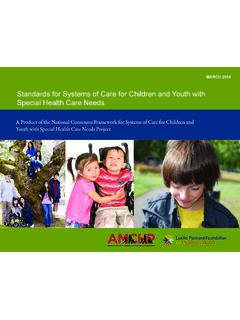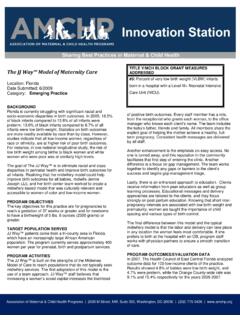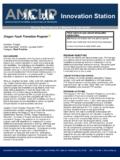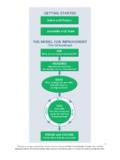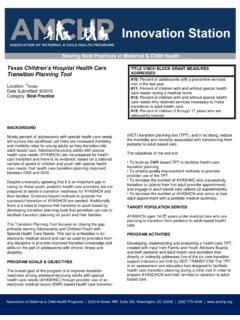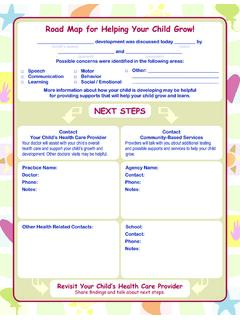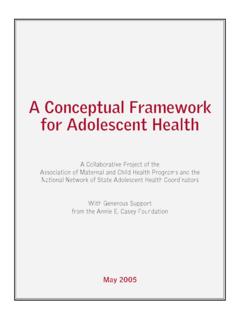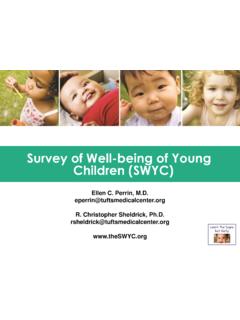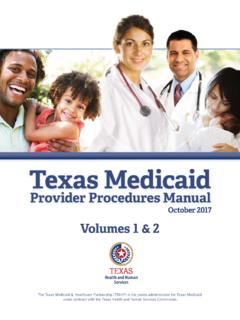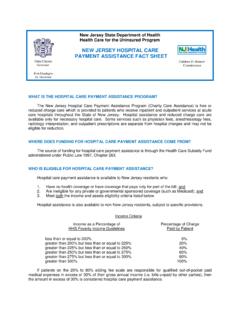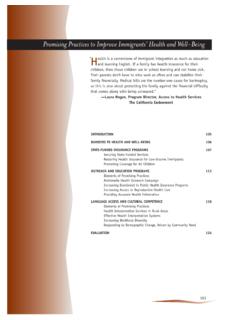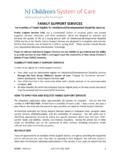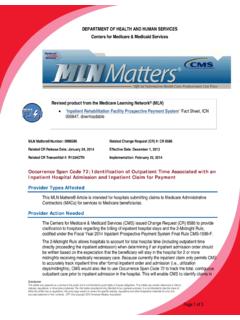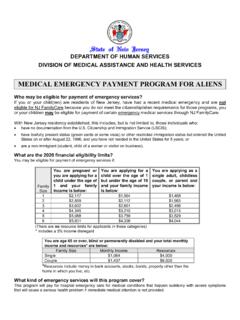Transcription of Using the Six Core Elements of Health Care …
1 Association of Maternal & Child Health Programs | 2030 M Street, NW, Suite 350, Washington, DC 20036 | (202) 775-0436 | Using the Six Core Elements of Health care transition in medicaid Managed care Location: Washington, Date Submitted: 5/2016 Category: Promising Practice BACKGROUND In 2011, professional recommendations on the transition from pediatric to adult care for youth and young adults were published by the American Academy of Pediatrics, American Academy of Family Physicians, and American College of Physicians in a clinical report titled Supporting the Health care transition From Adolescence to Adulthood in the Medical Home. Using those clinical recommendations, Got transition (the federally-funded Center for Health care transition Improvement) created the Six Core Elements of Health care transition , a set of clinical quality improvement tools for use in pediatric and adult settings. Although most managed care plans have an organized process for hospital to home transitions, few have a systematic process in place for transition from pediatric to adult Health care .
2 With funding from the DC Department of Health Title V Program, Got transition (operated by The National Alliance to Advance Adolescent Health ) began a transition pilot project in Washington, DC to improve this transition to adult care in Health Services for Children with Special Needs (HSCSN), a DC-based managed care plan with 6,000 enrollees (from birth to age 26). The project intended to incorporate the Six Core Elements of Health care transition into a medicaid managed care plan by customizing and integrating transition core Elements within a medicaid plan's existing care management processes. PROGRAM OBJECTIVES To customize the Six Core Elements of Health care transition for use by a medicaid MCO and to pilot this approach with the Health plan, enrollees, and pediatric and adult practices. To ensure more effective preparation for adult-centered care , a smooth transfer from pediatric to adult care , and a solid integration into adult care for CYSHCN. To develop shared accountability for transition with a managed care system and pediatric and adult practices.
3 To evaluate transition improvements made by MCO and to elicit consumer feedback Using Got transition measurement tools. TARGET POPULATION SERVED After customizing the Six Core Elements and recruiting pediatric and adult practices, the program piloted the new transition process and tools with a group of 35 young adult enrollees with chronic mental Health , developmental, and complex medical conditions. At the time of the project, HSCSN had a total of 1,417 enrollees, ages 18 25, with mental Health , developmental, and complex medical conditions that qualified them as SSI-eligible. PROGRAM ACTIVITIES The activity used for this pilot program was the customization and integration of the Six Core Elements of Health care transition (which consist of a transition policy, transition tracking and monitoring, transition readiness assessment, transition planning, transfer of care , and transfer completion) into the managed care organization. There are three distinct Six Core Elements packages: 1) transitioning youth to an adult-focused provider; 2) transitioning youth to an adult approach to Health care without changing providers; and 3) integrating young adults into adult Health care .
4 Because the program involved transferring young adults out of pediatric care , Got transition and HSCSN used the sample tools from the first package. At the outset of the project, Got transition staff met regularly with senior HSCSN care management staff to customize the TITLE V/MCH BLOCK GRANT MEASURES ADDRESSED #12: Percent of children with and without special Health care needs who received services necessary to make transitions to adult Health care Using the Six Core Elements of Health care transition in medicaid Managed care 2 | P a g e INNOVATION STATION | Sharing Best Practices in MCH Six Core Elements for use in the pilot project. All of the transition materials, for example, had to be at a 5th-grade reading level consistent with DC medicaid requirements. The customized transition package was reviewed by young adult HSCSN advisory group members. Once HSCSN's transition intervention was approved by its plan leadership, the pilot phase began.
5 A single nurse care manager and an AmeriCorps volunteer with public Health training were assigned responsibility for implementing the new Health care transition intervention with the pilot group. Weekly updating, transition mentoring, and trouble-shooting calls and meetings with Got transition staff followed. The first step of the pilot project was to select and invite 3 pediatric primary care practices with a large number of HSCSN members and 1 adult practice near the pediatric sites. Following the invitation and follow-up phone calls, the HSCSN/Got transition project team met with each site's clinical staff for 1 or 2 lunch and learn sessions to review HSCSN's customized version of the Six Core Elements , the list of potential pilot members from their practices, and the respective responsibilities of the practice and the managed care plan. The HSCSN nurse care manager and AmeriCorps volunteer then contacted eligible members from the 3 pediatric practices and invited them to participate, providing a detailed explanation of the project.
6 The pilot project involved a customization of the Six Core Elements , significantly modifying the transition policy and transition care plan for the project. The new transition policy was customized to be similar to the plan's insurance transition policy written as a question followed by a set of brief answers and was shared with pilot enrollees and participating practices. HSCSN already had a well-defined plan of care template that was expanded to include a section on Health care transition that identified enrollee skills needed based on the transition readiness assessment results and the priorities identified from the pilot group's completion of the transition plan of care from Got transition 's Six Core Elements sample tool. In addition, a new integrated care plan was developed that addressed not only Health care but also Health insurance, independent living, supported decision-making and guardianship, personal care , transportation, education and vocational training, employment, and social and recreation supports.
7 It was completed at the point of transfer to adult care in order to facilitate better coordination and referral to related community transition supports. HSCSN's transition registry, medical summary and emergency care plan, transfer checklist, and transition feedback survey remained essentially the same as the Six Core Elements sample tools. PROGRAM OUTCOMES/EVALUATION DATA At the outset of the project, the medicaid MCO was at the basic level (Level 1, out of 4) in terms of implementing the Six Core Elements , according to their scoring on the quality improvement measurement tool ( Current Assessment of Health care transition Activities ). After six months of implementing the pilot, the MCO scored at Level 3 on each of the Six Core Elements , reflecting its overall accomplishments and demonstrating the key role of nurse care managers in the MCO s success. The pilot project also utilized the Health care transition Feedback Survey to receive feedback from pilot group members after their initial adult primary care provider (PCP) visit.
8 Most young adults reported that their pediatric provider talked with them without their parents in the room and explained things in an understandable way, listened carefully, respected their beliefs, and informed them about the need to change doctors. Despite the fact that the MCO young adults did cite gaps in transition support from their pediatric providers, 80% said that they felt very prepared to change to an adult doctor. Data was also collected on the number of young adults who completed each core element within 6 months of the start of the pilot. Over 80% (30/35) of the pilot group received information about HSCSN's Health care transition policy and completed the transition readiness/self- care assessment form (29/35) and integrated transition plan (29/35), which was incorporated into HSCSN's plan of care , and a medical summary was prepared for them (29/35). Despite the high rate of HSCSN's completion of the transition policy, readiness assessment, and plan of care with its pilot participants, completion of transfer to the adult PCP was more difficult and had a lower rate of completion as a result (9/35).
9 Six months into the pilot, a total of 16 of the 35 pilot group enrollees (46%) were scheduled for an adult PCP visit, and 16 had their transfer package sent to the adult PCP. Nine of the 16 (56%) kept their first adult PCP visit. All of the 9 young adults who made their first adult visit and 1 who went to the last pediatric visit completed the transition feedback survey. PROGRAM COST Implementing the Six Core Elements into a medicaid managed care program was supported by a grant to The National Alliance to Advance Adolescent Health (which runs Got transition /the Center for Health care transition Improvement) from the DC Department of Health ( ). HSCSN received a subgrant to support the participation of its care managers. ASSETS & CHALLENGES Assets The results of this first-of-its-kind transition project reveal that the Six Core Elements of Health care transition can be customized and incorporated for use by care managers within a managed care plan in a short time frame. Managed care plans are in an excellent position to partner with state Using the Six Core Elements of Health care transition in medicaid Managed care 3 | P a g e INNOVATION STATION | Sharing Best Practices in MCH professional chapters of physician and nursing societies to offer practice-wide in-service programs on pediatric-to-adult transition and share best practices, including the Six Core Elements of Health care transition in order to increase everyone's comfort with this key part of the medical system's responsibility.
10 Challenges Many pilot group members had not seen their pediatric PCP in the last year and needed to make an additional pediatric visit to bring their medical summary and emergency care plan up-to-date to facilitate transfer to an adult PCP within a short time frame. It was difficult to reach several of the enrollees in order to schedule appointments despite instituting a variety of outreach efforts, including texting, reminder calls the day before, and visiting the home. The 18 and older age group is a highly transient population, and their telephone numbers are often changing, making communication time-consuming and challenging. It was often difficult to find adult practices interested in taking care of medicaid -insured young adults with chronic conditions. Overcoming Challenges As the project progressed, texting became a useful strategy for those who gave HSCSN permission to contact them Using this method. To find adult practices interested in taking care of medicaid -insured young adults with special Health care needs, financial incentives will likely be key.

